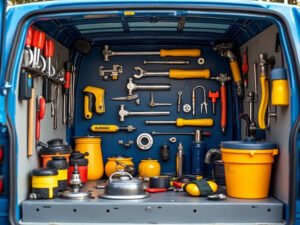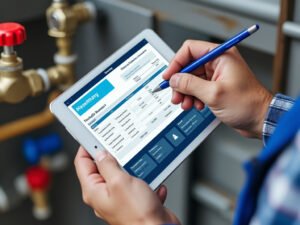The Tools of The Trade, a New Plumbers Guide

Hey there, budding plumber! You’ve taken your first steps into the mystical world of pipes, wrenches, and the occasional unexpected flood. Welcome! Today, we’re not just talking about tools; we’re diving into the heart of your new life’s adventure. Let’s explore “The Tools of The Trade” with a dash of humor, a sprinkle of wisdom, and a whole lot of practicality.
The Plumber’s Toolbox: Your New Best Friend
Imagine your toolbox as your own personal superhero utility belt. Each tool isn’t just a piece of metal or plastic; it’s a gadget with its own superpower.
- The Adjustable Wrench: Think of it as your Swiss Army Knife. It fits almost anything, but remember, it’s not a hammer.
- Pipe Cutters: These are your precision lasers, slicing through metal like butter. No, they won’t cut through your sandwich, but they’ll make quick work of any pipe.
- Plunger: The unsung hero. It’s not glamorous, but when you’re facing a clog, it’s your best friend. Treat it with respect; it’s saved many a plumber’s day.
Must Have Tools in Your Plumbing Truck
Top 10 Tools Every Plumber Should Have in Their Van
Hey there, apprentice! Your van is like your mobile workshop, your Batmobile for battling plumbing woes. Here’s your checklist for the top 10 tools you absolutely need to keep your plumbing game on point:
- Plumbers Adjustable Wrench: This is your go-to for most jobs. It adjusts to fit various sizes of nuts and bolts. Think of it as your plumbing multitool.
- Pipe Wrench for Plumbers: For those stubborn, larger pipes that need a bit more muscle. It’s like bringing in the heavy artillery when regular wrenches just won’t do.
- Toilet Plunger: The unsung hero of plumbing. It’s not just for toilets; it’s your first line of defense against clogs anywhere.
- Basin Wrench: Designed for reaching those hard-to-get-to nuts under sinks. It’s like having an extra-long arm that can twist and turn.
- Pipe Cutters: For clean, precise cuts on pipes. It’s your precision tool, ensuring no jagged edges that could lead to future leaks.
- Commercial Screwdriver Set: You’ll need various types (Phillips, flathead, Torx) for different fixtures and screws. It’s like having a set of keys for different locks.
- Tape Measure: For accurate measurements. Whether you’re cutting pipes or planning layouts, precision is key.
- Plumber’s Tape (Teflon Tape): Essential for creating watertight seals on threaded pipe joints. It’s like the glue that holds your plumbing together.
- Hacksaw: For cutting through plastic, metal, or even wood when needed. It’s your versatile cutting tool.
- Auger (Drain Snake): For those clogs that the plunger can’t handle. It’s like sending a spy down the drain to clear the way.
Bonus Tools for the Well-Prepared Plumber:
- Torpedo Level: For ensuring your pipes are installed level, preventing future issues.
- Channel-Lock Pliers: For gripping and turning things that wrenches can’t quite handle.
- Flashlight: Because sometimes, you’re working in the dark corners of someone’s basement or under a sink.
The Plumber’s The Tools of The Trade
- Organization: Keep your tools organized. A cluttered van leads to lost time and tools.
- Maintenance: Regularly check and maintain your tools. A well-kept tool is a reliable tool.
- Adaptability: Sometimes, you might need a tool not on this list. Being adaptable and resourceful is part of the job.
The Art of Tool Maintenance
- Cleanliness: After every job, clean your tools. Imagine eating with dirty utensils. Not pleasant, right? Your tools deserve better.
- Storage: Store them like you would your favorite video game collection. Organized, dry, and safe from harm.
- Sharpening and Oiling: Keep blades sharp and moving parts oiled. A well-maintained tool is like a well-oiled machine – it just works better.
Why Tools Matter
- Efficiency: The right tool for the job means less time, less effort, and more success.
- Safety: Using tools correctly reduces the risk of injury. A slip with a wrench can be as painful as a slip with words.
- Professionalism: Your tools reflect your professionalism. A plumber with well-kept tools is a plumber who takes pride in their work.
Your Journey with Tools
As you embark on this journey, remember:
- Learn: Each tool has a story, a history, and a purpose. Dive into that knowledge.
- Respect: Treat your tools with respect, and they’ll serve you well.
- Innovate: Sometimes, you’ll need to think outside the box. But always come back to the basics.
So, apprentice, as you fill your toolbox, remember, you’re not just collecting tools; you’re building a relationship with each one. They’re your partners in this wild, wet, and wonderful world of plumbing.
#PlumbingTools #NewPlumber #ToolTales
